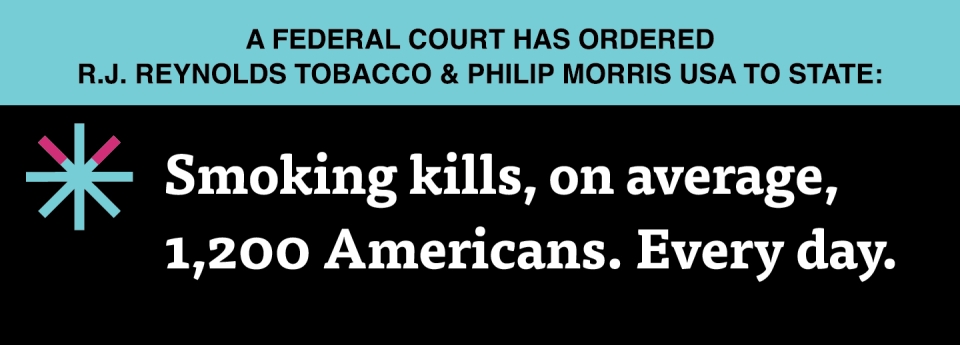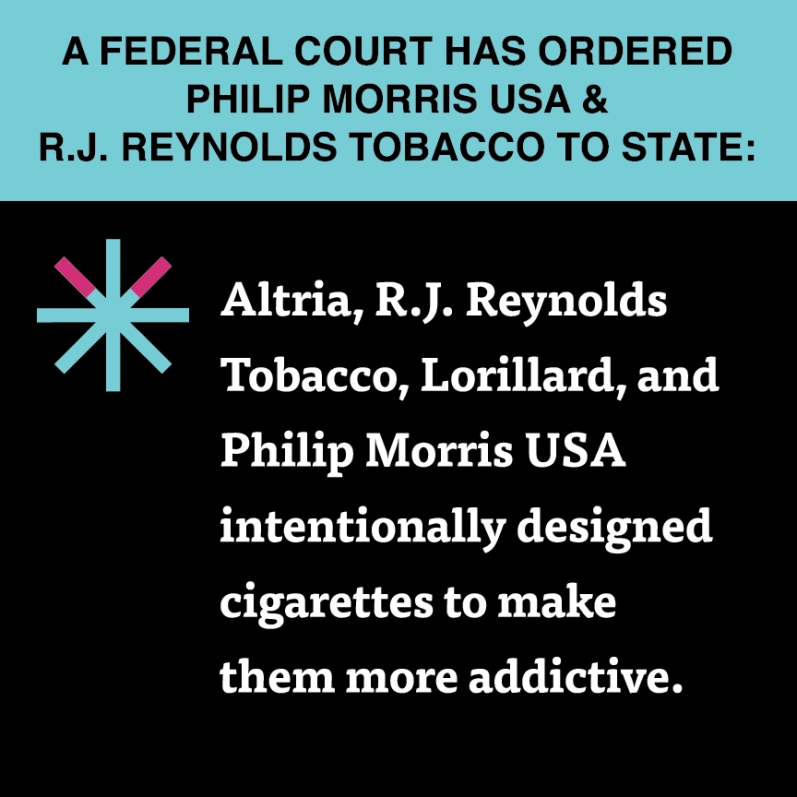Update October 2023: Find the tip-line here: tobaccosigntipline.com or text: 877-749-TIPS (8477); find a list tip-line FAQS and a list of participating retailers from the Campaign for Tobacco Free Kids page Corrective Statements: Opportunities for Action; and learn more in our podcast episode on the corrective statements at the point of sale.
Starting July 1, 2023, over 200,000 tobacco retailers across the country must begin installing signs in their stores with “corrective statements” from the tobacco industry. This is a long-awaited result of a 2006 federal court case ruling in which major tobacco companies were found guilty of racketeering for deliberately misleading the public about the health risks of smoking and secondhand smoke and the addictive nature of their products. The signs are intended to correct the record on the topics the tobacco industry lied about and to prevent future fraud by the tobacco industry. The tobacco industry spends the large majority of all of their marketing dollars in the retail environment – to the tune of over $7 billion dollars in 2020 alone, amounting to nearly $1 million per hour. And they’re spending it there for good reason – because they know exposure to tobacco marketing in retail stores leads kids to start using tobacco products and makes it harder for adults who currently use tobacco to quit. Now they must use the retail environment to also tell the harsh truth about the deadly products they aggressively market and sell and how they have lied about their health impacts for decades.
Examples of the corrective statements include:
- Smoking kills, on average, 1,200 Americans. Every day.
- Cigarette companies intentionally designed cigarettes with enough nicotine to create and sustain addiction.
- All cigarettes cause cancer, lung disease, heart attacks, and premature death – lights, low tar, ultra lights, and naturals. There is no safe cigarette.
- Altria, R.J. Reynolds Tobacco, Lorillard, and Philip Morris USA intentionally designed cigarettes to make them more addictive.
- When you smoke, the nicotine actually changes the brain – that’s why quitting is so hard.
- Children exposed to secondhand smoke are at an increased risk for sudden infant death syndrome (SIDS), acute respiratory infections, ear problems, severe asthma, and reduced lung function.
Read the full text of these court-ordered corrective statements.
The requirement to post these corrective statements at the point of sale follows requirements to publish the same statements in newspapers and on television (which ran 2017-2018), on their websites (beginning in Nov. 2018 and running in perpetuity), and on cigarette packs (beginning Nov 2018 – 2021 for two weeks at a time, three times a year over the course of two years).
Why are retailers required to post these signs if it was the tobacco companies that deceived the public?
Many tobacco retailers have contracts with tobacco companies that impose requirements on how tobacco products are displayed, promoted, and priced in retail stores (learn more about these contracts in our recent podcast episode on the contracts between tobacco retailers and tobacco companies: impact on the retail environment). Now, major tobacco companies including Altria, Philip Morris USA, R.J. Reynolds Tobacco Company, and 4 cigarette brands owned by ITG Brands LLC, will be required to modify those contracts to require retailers to post signs with corrective statements.
What’s the timeline?
- “Ramp-up Period”: January 1, 2023 – June 30, 2023. This is when the tobacco companies will modify their existing contracts with tobacco retailers to include requirements to post the corrective statements.
- “Posting period”: July 1, 2023 – September 30, 2023. This is when the initial round of signs must be installed.
- “Implementation period”: October 1, 2023 – June 30, 2025. This is when the signs must be displayed.
- “Rotation period” Signs will rotate between July 1, 2024 – September 30, 2024.
What will the signs look like?
According the text of the court order, retailers will be required to post a single sign that is 144 sq in. and “placed a highly visible location within 48” of the main customer entrance of the store, that can be seen by customers as the enter the store, and at least 48” above the floor.”
Kiosk stores will be required to post the sign “near the selling window, highly visible to the customer, and that can be seen by customers as they approach or are standing at the selling window. “


See more images of the point-of-sale signs.
How will posting of the signs be enforced?
Tobacco companies will be required to contract with an auditor to ensure retailers are posting the signs as required, and they will also be required to create a tip line for the general public to report retailers that are out of compliance. If a retailer has repeat violations of noncompliance, they may be required to post a second sign or pay a fine to the tobacco company. If more than 15% of retailers with a contract with a given tobacco company are found noncompliant by the auditor, the tobacco company could also face fines.
What opportunities are there to amplify the corrective statements impact?
While these signs will still likely be dwarfed by the rest of tobacco industry’s marketing materials at the point of sale, they could serve as an opportunity to engage retailers and/or the public in conversations about ways to limit the tobacco industry’s influence going forward, including through:
- Educating decision makers and the public about tobacco industry contracts with retailers and ways to limit their impact on public health. Examples include restrictions on retailer density (through licensing or zoning) that limit the number, type, and/or location of tobacco retailers, prohibiting price discounts, setting minimum floor prices for tobacco products, restricting advertising at the point of sale, restricting tobacco product displays, and more.
- Conversations with retailers about transitioning away from selling tobacco or making other voluntary changes, like reducing tobacco advertising in their stores that is not required under their contracts with retailers or moving products away from kid-friendly items.
- Pointing towards quit-lines and other cessation resources and requiring quit-line information to be posted at the point of sale as well.
Learn more
Learn more about the racketeering verdict, which was the result of a lawsuit brought by the US Department of Justice and six intervening public health groups: Tobacco-Free Kids Action Fund (a 501(c)(4) affiliate of the Campaign for Tobacco-Free Kids), American Cancer Society, American Heart Association, American Lung Association, Americans for Nonsmokers’ Rights and National African American Tobacco Prevention Network.


